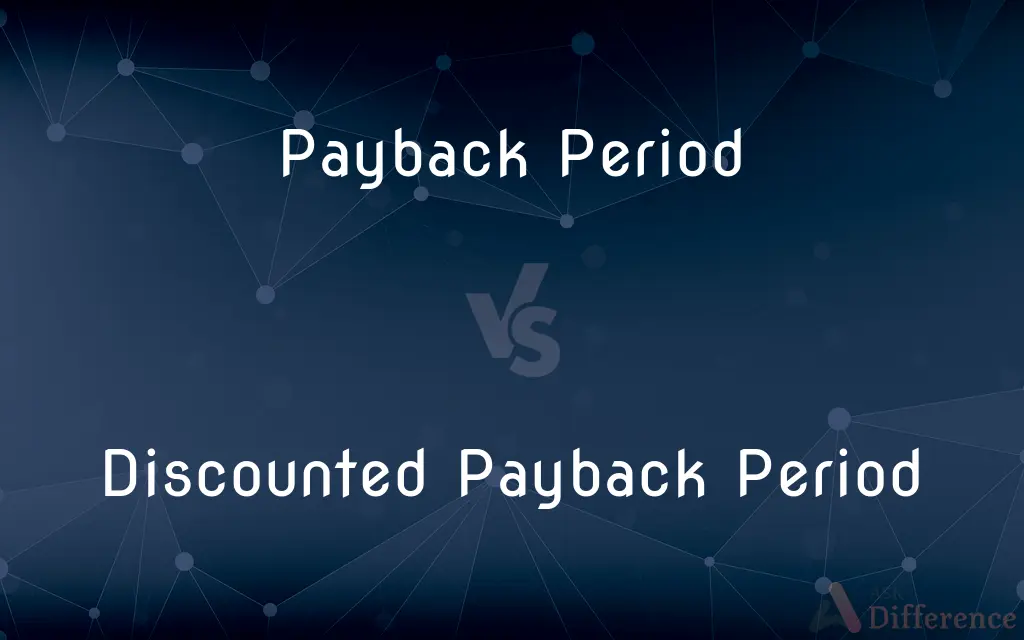Payback Period vs. Discounted Payback Period — What's the Difference?
By Tayyaba Rehman — Published on November 22, 2023
Payback Period refers to the time it takes for an investment to generate an equal return, while Discounted Payback Period accounts for the time value of money, adjusting each cash inflow for present value.

Difference Between Payback Period and Discounted Payback Period
Table of Contents
ADVERTISEMENT
Key Differences
Payback Period and Discounted Payback Period serve as methods to assess investment feasibility and risk.
The Payback Period is the time required for an investment to recoup its initial cost, while the Discounted Payback Period additionally considers the time value of money in this calculation.
Notably, Payback Period is easier and quicker to calculate compared to the Discounted Payback Period, as it doesn’t account for the diminishing value of future cash inflows.
Both the Payback Period and Discounted Payback Period do not consider cash flows received after the payback period, which can exclude valuable context in investment analysis.
While Payback Period may provide a simplistic and optimistic forecast, Discounted Payback Period provides a more conservative and realistic assessment by discounting future cash flows.
ADVERTISEMENT
Comparison Chart
Consideration of Time Value
Does not consider
Considers
Complexity
Less complex
More complex due to discounting
Risk Assessment
May underestimate
Provides a more accurate picture
Calculation Method
Sums cash inflows
Sums discounted cash inflows
Risk and Return Analysis
May not accurately reflect risk
Provides better risk and return analysis
Compare with Definitions
Payback Period
Payback Period is the duration required to recover the original investment.
A three-year Payback Period indicates full recovery of the initial investment after three years.
Discounted Payback Period
It’s viewed as a conservative and realistic financial analysis tool.
The Discounted Payback Period may yield longer recovery time estimates due to its discounting mechanism.
Payback Period
Payback Period ignores cash inflows received after the payback period.
Payback Period does not evaluate the profitability or viability beyond the recovery duration.
Discounted Payback Period
Discounted Payback Period better reflects risk and potential returns.
The Discounted Payback Period assesses the genuine economic profitability and risk of investments.
Payback Period
Payback Period is expressed in time units, commonly years or months.
A Payback Period of five years signals a half-decade recovery time for the initial outlay.
Discounted Payback Period
Discounted Payback Period considers the time value of money.
Discounted Payback Period adjusts future cash flows for present value, refining investment analysis.
Payback Period
It provides a basic risk assessment tool.
Shorter Payback Periods are typically perceived as less risky investments.
Discounted Payback Period
It provides a more rigorous investment analysis than the Payback Period.
The Discounted Payback Period accounts for diminishing cash inflow values over time.
Payback Period
It doesn't account for the time value of money.
Payback Period merely counts the cash inflows without considering their present value.
Discounted Payback Period
It's expressed in time, often years, incorporating discounted cash inflows.
A Discounted Payback Period of six years factors in present value adjustments during that timeframe.
Common Curiosities
What are the Payback Period and Discounted Payback Period?
Payback Period is recovery time for investment; Discounted Payback Period also considers the time value of money.
Can the Payback Period and Discounted Payback Period yield different results?
Yes, since the Discounted Payback Period considers the time value of money, it may show a longer recovery period.
Why consider the Discounted Payback Period over the Payback Period?
Discounted Payback Period offers a more precise investment analysis by acknowledging the time value of money.
How is the Payback Period calculated?
It's calculated by dividing the initial investment by the annual cash inflow.
Which is easier to calculate between Payback Period and Discounted Payback Period?
The Payback Period is easier due to its non-consideration of the time value of money.
How is the Discounted Payback Period calculated?
It utilizes discounted cash inflows to account for the time value of money in the payback duration.
Are the Payback Period and Discounted Payback Period sufficient for investment decisions?
They provide insight but considering additional metrics like NPV or IRR is often advisable for comprehensive analysis.
What is a major limitation of the Payback Period?
It ignores the time value of money and cash inflows received after the payback period.
What does a shorter Payback Period indicate?
A shorter Payback Period implies quicker recovery of the initial investment.
Which metric between Payback Period and Discounted Payback Period is considered more conservative?
The Discounted Payback Period is viewed as more conservative due to its inclusion of the time value of money.
How can the Payback Period impact financial decision-making?
It provides a quick, albeit basic, assessment of how swiftly an investment might be recovered.
What is the impact of discount rate variation on the Discounted Payback Period?
An increased discount rate will typically extend the Discounted Payback Period, suggesting a riskier investment.
Can a project be viable with a lengthy Discounted Payback Period?
Possibly, but it could be perceived as riskier and demands thorough evaluation considering various financial metrics.
How do the Payback Period and Discounted Payback Period relate to risk?
Shorter Payback Periods are often perceived as less risky, while the Discounted Payback Period provides a more realistic risk portrayal.
Does the Discounted Payback Period align with all investment types?
It may be more suitable for investments where future cash inflow values significantly depreciate due to factors like inflation.
Share Your Discovery

Previous Comparison
Polyethylene Glycol vs. Propylene Glycol
Next Comparison
Iron Sulfate vs. Iron GluconateAuthor Spotlight
Written by
Tayyaba RehmanTayyaba Rehman is a distinguished writer, currently serving as a primary contributor to askdifference.com. As a researcher in semantics and etymology, Tayyaba's passion for the complexity of languages and their distinctions has found a perfect home on the platform. Tayyaba delves into the intricacies of language, distinguishing between commonly confused words and phrases, thereby providing clarity for readers worldwide.












































